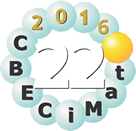

 |
Célia M. Ronconi Célia M. Ronconi received her BA degree (1995) in Chemistry from Londrina State University (UEL), MSc (1998) degree from the Federal University of São Carlos (UFSCar) and PhD in Inorganic Chemistry (2002) from the University of Campinas (UNICAMP), Brazil. From 2003-2005 she was a post-doctoral fellow working with Prof. J. F. Stoddart at the Department of Chemistry and Biochemistry, UCLA, Los Angeles, CA, USA. From 2006-2009 she was Associate Professor at the Department of Inorganic Chemistry at the Federal University of Rio de Janeiro (UFRJ). Currently, she is Associate Professor at the Department of Inorganic Chemistry at Fluminense Federal University (UFF), director of the Materials Chemistry Division of the Brazilian Chemical Society and Researcher of the National Council for Scientific and Technological Development (CNPq). Her present research is focused on the synthesis of coordination polymers and hybrid materials for CO2 capture, biodiesel production and drug delivery systems (cancer and leishmaniosis). |
Célia M. Ronconi
Instituto de Química, Universidade Federal Fluminense (UFF), Outeiro de São João Batista, s/n, Campus do Valonguinho, Centro, 24020-141, Niterói, RJ, Brazil
Resumo
In this work we are going to show how photoluminescent properties of Ag(I)-based coordination polymers are adjusted by changing the building blocks in the self-assembly process. A series of luminescent Ag(I)-based coordination polymers have been self-assembled from two flexible dicyanomethylene ligands bearing diethylene and triethylene glycol spacers and silver salts in different solvents. Single crystal X–ray diffraction analyses reveal a variety of geometries around the Ag(I) ion, resulting in mono, bi and tetranuclear networks with intriguing topologies. The coordination networks showed 2D architectures through coordination of the cyano and glycolic groups to the Ag(I) ions. A 3D supramolecular arrangement of the coordination networks was formed through weak π…π and Ag(I)…π interactions as well as the hydrogen bonds between water molecules and ClO4— and BF4— counterions. Ag(I) coordination networks display green to yellow emissions in the solid state, with quantum yields (Φem) varying from 0.013 to 0.085. The emission properties of the silver(I) coordination networks are attributed to intraligand charge transfer and metal-perturbed intraligand transitions. Structural properties, such as the presence of Ag…π interactions and multiple silver(I) centers of in the coordination networks play an import role in the photophysical properties of these compounds.